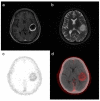Oncogenesis, Microenvironment Modulation and Clinical Potentiality of FAP in Glioblastoma: Lessons Learned from Other Solid Tumors
- PMID: 34068501
- PMCID: PMC8151573
- DOI: 10.3390/cells10051142
Oncogenesis, Microenvironment Modulation and Clinical Potentiality of FAP in Glioblastoma: Lessons Learned from Other Solid Tumors
Abstract
Currently, glioblastoma (GBM) is the most common malignant tumor of the central nervous system in adults. Fibroblast activation protein (FAP) is a member of the dipeptidyl peptidase family, which has catalytic activity and is engaged in protein recruitment and scaffolds. Recent studies have found that FAP expression in different types of cells within the GBM microenvironment is typically upregulated compared with that in lower grade glioma and is most pronounced in the mesenchymal subtype of GBM. As a marker of cancer-associated fibroblasts (CAFs) with tumorigenic activity, FAP has been proven to promote tumor growth and invasion via hydrolysis of molecules such as brevican in the extracellular matrix and targeting of downstream pathways and substrates, such as fibroblast growth factor 21 (FGF21). In addition, based on its ability to suppress antitumor immunity in GBM and induce temozolomide resistance, FAP may be a potential target for immunotherapy and reversing temozolomide resistance; however, current studies on therapies targeting FAP are still limited. In this review, we summarized recent progress in FAP expression profiling and the understanding of the biological function of FAP in GBM and raised the possibility of FAP as an imaging biomarker and therapeutic target.
Keywords: fibroblast activation protein; glioblastoma; imaging biomarker; immunosuppression; therapeutic target; tumorigenesis.
Conflict of interest statement
The authors declare no conflict of interest.
Figures


Similar articles
-
Characterization and oncolytic virus targeting of FAP-expressing tumor-associated pericytes in glioblastoma.Acta Neuropathol Commun. 2020 Dec 11;8(1):221. doi: 10.1186/s40478-020-01096-0. Acta Neuropathol Commun. 2020. PMID: 33308315 Free PMC article.
-
Fibroblast activation protein alpha is expressed by transformed and stromal cells and is associated with mesenchymal features in glioblastoma.Tumour Biol. 2016 Oct;37(10):13961-13971. doi: 10.1007/s13277-016-5274-9. Epub 2016 Aug 4. Tumour Biol. 2016. PMID: 27492457
-
Design and validation of fibroblast activation protein alpha targeted imaging and therapeutic agents.Theranostics. 2020 Apr 27;10(13):5778-5789. doi: 10.7150/thno.41409. eCollection 2020. Theranostics. 2020. PMID: 32483418 Free PMC article.
-
The application of the fibroblast activation protein α-targeted immunotherapy strategy.Oncotarget. 2016 May 31;7(22):33472-82. doi: 10.18632/oncotarget.8098. Oncotarget. 2016. PMID: 26985769 Free PMC article. Review.
-
Theranostics in targeting fibroblast activation protein bearing cells: Progress and challenges.Life Sci. 2023 Sep 15;329:121970. doi: 10.1016/j.lfs.2023.121970. Epub 2023 Jul 21. Life Sci. 2023. PMID: 37481033 Free PMC article. Review.
Cited by
-
Role of FGF21 in mediating the effect of phosphatidylcholine on GBM.Front Oncol. 2024 Sep 2;14:1428025. doi: 10.3389/fonc.2024.1428025. eCollection 2024. Front Oncol. 2024. PMID: 39286013 Free PMC article.
-
The axis of tumor-associated macrophages, extracellular matrix proteins, and cancer-associated fibroblasts in oncogenesis.Cancer Cell Int. 2024 Oct 7;24(1):335. doi: 10.1186/s12935-024-03518-8. Cancer Cell Int. 2024. PMID: 39375726 Free PMC article. Review.
-
The Prognostic and therapeutic value and clinical implications of fibroblast activation protein-α as a novel biomarker in colorectal cancer.Cell Commun Signal. 2023 Jun 14;21(1):139. doi: 10.1186/s12964-023-01151-y. Cell Commun Signal. 2023. PMID: 37316886 Free PMC article. Review.
-
Tracking tumor alteration in glioma through serum fibroblast activation protein combined with image.BMC Cancer. 2023 Oct 20;23(1):1012. doi: 10.1186/s12885-023-11544-4. BMC Cancer. 2023. PMID: 37864148 Free PMC article.
-
FAP: Not Just a Biomarker but Druggable Target in Liver Fibrosis.Cell Mol Gastroenterol Hepatol. 2023;15(4):1018-1019. doi: 10.1016/j.jcmgh.2022.12.018. Epub 2023 Jan 18. Cell Mol Gastroenterol Hepatol. 2023. PMID: 36681094 Free PMC article. No abstract available.
References
-
- Hombach-Klonisch S., Mehrpour M., Shojaei S., Harlos C., Pitz M., Hamai A., Siemianowicz K., Likus W., Wiechec E., Toyota B.D., et al. Glioblastoma and chemoresistance to alkylating agents: Involvement of apoptosis, autophagy, and unfolded protein response. Pharmacol. Ther. 2018;184:13–41. doi: 10.1016/j.pharmthera.2017.10.017. - DOI - PubMed
Publication types
MeSH terms
Substances
Grants and funding
- 81201121/National Natural Science Foundation of China
- 7202150/Beijing Municipal Natural Science Foundation
- 19JCZDJC64200(Z)/Beijing Municipal Natural Science Foundation
- 2016-I2M-2-001/Chinese Academy of Medical Sciences Innovation Fund for Medical Sciences
- 2018-I2M-3-001/Chinese Academy of Medical Sciences Innovation Fund for Medical Sciences
LinkOut - more resources
Full Text Sources
Medical
Research Materials
Miscellaneous

